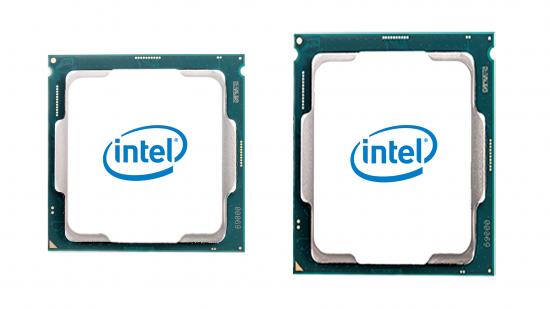Is this oblong chip the future of Intel’s desktop CPUs? Two renowned leakers have tweeted about a potential Intel LGA 1700 socket, a stretched out socket that would mark a departure from Intel’s tried and tested square chips. While this remains largely conjecture at this point, the socket is suspected to be the shape of things to come with Intel’s Alder Lake CPUs, likely the first desktop generation built upon the company’s 10nm process node.
Both Momomo_US and Komachi_Ensaka, two well-known leakers of PC hardware goodies, have tweeted out the LGA 1700 reference. A massive step up in pin count from today’s LGA 1151 configuration with Coffee Lake, which is expected to be superseded by the LGA 1200 socket with Intel Comet Lake, there’s plenty of speculation to be had as to why Intel’s potentially eyeing up a change in design.
The (dubious on all counts) socket change would potentially follow Rocket Lake, the 14nm desktop generation currently rumoured to follow Intel Comet Lake, and put an end to any socket backwards compatibility that may be available between the two generations. It would also likely require cooler manufacturers to redesign their brackets to accommodate the change.
Little is known about the suggested Alder Lake architecture beyond its use of Intel’s 10nm process node, which is currently utilised within Intel Ice Lake mobile processors. The stunted release of this process has set Intel’s roadmap back somewhat, and at points it has been suggested that 10nm desktop production had been stripped from the company’s roadmap altogether. However, Intel dismissed these claims and cleared up its intentions to release 10nm chips sometime in the next few years.
🤔🤔🤔🤔🤔
ADL-S 45×37.5mm LGA1700.— 比屋定さんの戯れ言@Komachi (@KOMACHI_ENSAKA) January 2, 2020
So what’s Intel hiding under the redesigned hood?
Current 10nm designs operate on Intel’s latest Sunny Cove Core architecture. However, it is suspected that either Willow Cove, Sunny Cove’s successor, or Golden Cove following that, will be front and centre with so-called Alder Lake.
Tiger Lake will replace Ice Lake in mobile computing, and will integrated Willow Cove and Intel Xe, otherwise known as Gen12 graphics, into its design.
Intel has also said that its next Core architecture design will be “significantly bigger” that Sunny Cove. But that could be years away from our gaming PCs.
A potential departure from DDR4 memory, or PCIe 3.0, could be the root of some of the necessary changes. Both DDR5 and PCIe 4.0 (and even PCIe 5.0) are either in the market or on the way. Intel’s DMI link between the CPU and PCH, DMI 3.0, could also become a restriction on further bandwidth and I/O, which may require some tinkering down the line to improve performance and connectivity.
1150 – 1151 – 1200 – 1700 🤔
— 188号 (@momomo_us) January 2, 2020
Power delivery, real estate for greater core counts, on-die functionality, and larger integrated GPUs (Intel Xe/Gen1 2 integrated graphics) are also potential reasons for the sizeable chonk of the chip.
It’s worth noting that even LGA 1700, intended for client desktop chips, would be smaller than the current LGA 2066 socket used across Cascade Lake X HEDT processors.
Header image is my own franken-chip, so feel free to use your imagination as to Alder Lake’s orientation or IHS design.
